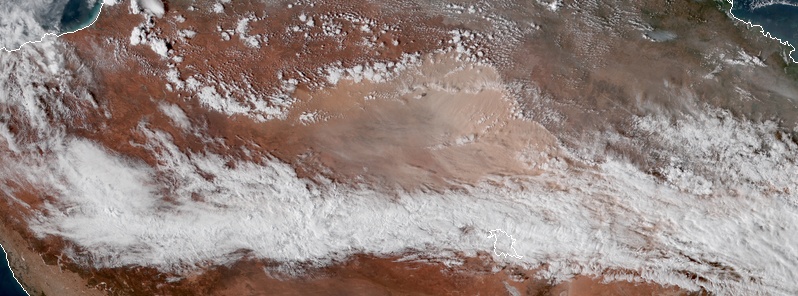Massive dust storm across Australia extends almost the total width of the continent

A trough moving through central Australia on January 11, 2020, lifted up huge amounts of dust, creating a massive dust storm — almost the entire width of the continent. The trough is expected to bring showers and storms to the southeast into Sunday morning, January 12.
The storm brought down visibility to as low as 100 m (328 feet) in Queensland, volunteer weather observers said. Meanwhile, visibility was reportedly less than 1 000 m (3 280 feet) in parts of the Channel County.
Dr. Santiago Gasso, an expert in aerosol remote sensing from the University of Washington, said the situation is "now on a continental scale."
"It was just like someone had put a piece of red cellophane over the Sun," said Sarah Cameron from Bollon– 100 km (62) miles west of Saint George.
"There was no wind, so it was just slowly creeping in and was quite eerie," she described. "We have had many dust storms come through in this crippling drought, but this would have to be the worst of them all."
man, this is tough, now a continental scale #duststorm in #Australia. @DustStormNews pic.twitter.com/m7CD4QkzCu
— Santiago Gassó (@SanGasso) January 11, 2020
Big old dust storm going through South West Queensland atm pic.twitter.com/iWwP1jt4qM
— Bek (@Redandblack91) January 11, 2020
Yet another #duststorm This one was at St George earlier today and has now arrived at Roma. #drought #Queensland pic.twitter.com/eaX7UdwYfl
— Sherrill Stivano (@bellevueluck) January 11, 2020
The dust storm is expected to continue toward east but would diminish before reaching the Darling Downs, said meteorologist Lauren Pattie. "As we move into the evening, the system moves eastwards and weakens a little bit."
Pattie continued, "There will be a little bit of dust haze around tomorrow, but it will slowly start to [ease] back."
Australia's Bureau of Meteorology said although the dust storm was intense, these types of weather events were not uncommon during the summer season.
"It is fairly common for us to see dust associated with fronts and troughs moving through," Pattie added. "It is helped by how dry it is in the southwest of the state at the moment."
The same trough that is bringing dust to the southwest is forecast to bring showers and storms to the southeast on Saturday night into Sunday morning, January 11 into 12.
Furthermore, isolated severe storms may dump up to 50 mm (2 inches) of rain, with flash flooding likely. Most showers will bring between 15 to 30 mm (0.6 to 1.2 inches) of rain.
Featured image credit: JMA/Himawari-8, RAMMB/CIRA at 06:40 UTC on January 11, 2020.

This is fake news and causes unnecessary anguish. Its the same rubbish we hear about Australia is on fire. The outside world has no idea how big this country is. We are a very large desert country and there is always a dust storm happening somewhere. But to say it is covering the whole continent is ridiculous. The ‘Australia is on fire’ stories has wrecked the tourist industry. In reality it is just small pockets. Tragic, yes, and very sad for those involved but I do wish people would get their stories right.